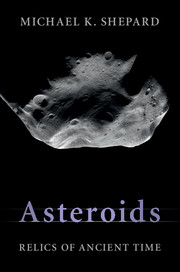Book contents
- Frontmatter
- Dedication
- Contents
- Preface
- Acknowledgements
- Brief list of asteroid and meteorite terms
- 1 It's a small world
- 2 A night at the zoo
- 3 It came from outer space
- 4 A day at the museum
- 5 The gambler's fallacy
- 6 Remembrance of things past
- 7 The ties that bind
- 8 Terra incognita
- 9 To your scattered bodies go
- 10 Scouts, sappers, and miners
- Glossary
- Bibliography
- Index
- References
2 - A night at the zoo
Published online by Cambridge University Press: 05 May 2015
- Frontmatter
- Dedication
- Contents
- Preface
- Acknowledgements
- Brief list of asteroid and meteorite terms
- 1 It's a small world
- 2 A night at the zoo
- 3 It came from outer space
- 4 A day at the museum
- 5 The gambler's fallacy
- 6 Remembrance of things past
- 7 The ties that bind
- 8 Terra incognita
- 9 To your scattered bodies go
- 10 Scouts, sappers, and miners
- Glossary
- Bibliography
- Index
- References
Summary
About ten months ago a report reached my ears that a Dutchman had constructed a telescope, by the aid of which visible objects, though at a great distance from the observer, were seen distinctly as if near…
Galileo, The Sidereal Messenger (translation by E. S. Carlos, 1880)SACRED GROUND
The largest volcano in the solar system sits on the surface of Mars: Olympus Mons, named for the sacred home of the Greek gods. Its smaller cousin on Earth, Mauna Kea, sits on the island of Hawaii and is the sacred home of Pele, the goddess of fire, lightning, wind, and volcanoes in the native Hawaiian religion.
Neither volcano resembles the traditional shape associated with explosive volcanoes – a steep sided, snow-capped peak, usually referred to as a stratovolcano. Instead, these are shield volcanoes, socalled because they have the wide and shallow aspect of a knight's shield. The difference in appearance is because of a fundamental difference in composition; stratovolcanoes are made of a sticky and explosive kind of lava called andesite (from the Andes mountains) while shield volcanoes are made of a more fluid and effusive lava called basalt. Sticky lava behaves like toothpaste or shaving cream; it would be relatively easy to sculpt a stratovolcano model on the kitchen table using either of these materials. Basaltic lava behaves more like pancake batter in a hot pan. It will spread out so that its breadth is always many times greater than its height.
Basalt is a more primitive lava than andesite. It is the first kind of lava one gets from melting planetary crust and we see it all over the ocean floors on Earth, in the mare, or dark regions, of the Moon, and in the lava flows that cover Mercury, Mars, and Venus. Andesite, on the other hand, is a secondary lava – a kind of recycled product. On Earth, it is produced by the re-melting of basalt as the ocean floors subduct beneath continental margins.
- Type
- Chapter
- Information
- AsteroidsRelics of Ancient Time, pp. 35 - 66Publisher: Cambridge University PressPrint publication year: 2015



